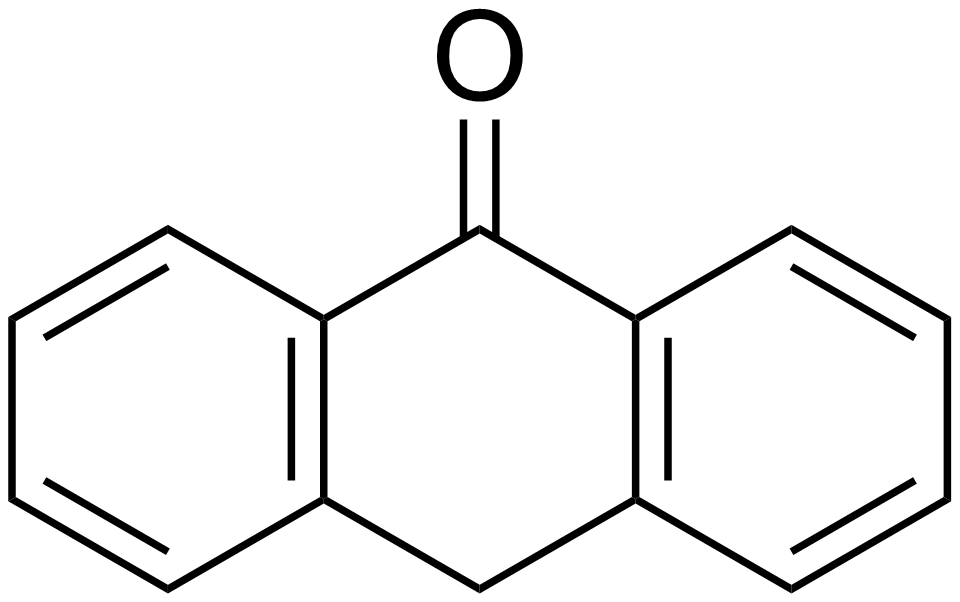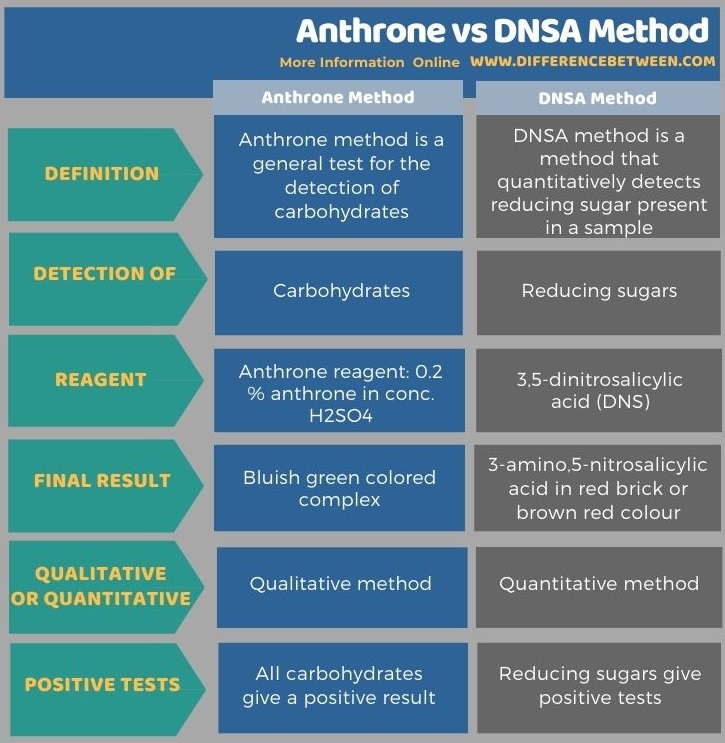Difference Between Anthrone and DNSA Method
The key difference between Anthrone and DNSA method is that Anthrone test is a general test to detect all types of carbohydrates while DNSA method is a quantitative method for the detection of reducing sugars.
Reducing sugar is a type of sugar that is able to reduce another compound. Therefore, it can act as a reducing agent. While reducing the other compound, reducing sugar undergoes oxidation. Structurally, reducing sugars have a free aldehyde or ketone group. All monosaccharides are reducing sugars. Some disaccharides, some oligosaccharides and some polysaccharides are also reducing sugars. Glucose, galactose and fructose are commonly known reducing sugars. There are several tests to detect the presence of reducing sugars. 3,5-dinitrosalicylic acid (DNSA method) is a quantitative method and Antrone test are two such tests.
CONTENTS
1. Overview and Key Difference
2. What is Anthrone Method
3. What is DNSA Method
4. Similarities Between Anthrone and DNSA Method
5. Side by Side Comparison – Anthrone vs DNSA Method in Tabular Form
6. Summary
What is Anthrone Method?
Anthrone method is a general test for carbohydrates. Anthrone is a tricyclic aromatic ketone. Anthrone reagent is the main reagent in concentrated sulfuric acid. Once anthrone reagent is added into the sample, carbohydrates in the sample dehydrate to form Furfural and then condense with anthrone to form a green colour complex. This green coloured complex can be measured colourimetrically at 620 nm in order to determine the carbohydrate present in the sample.

Figure 01: Anthrone
What is DNSA Method?
DNSA method is a quantitative method of detecting reducing sugars in a sample. In fact, it measures the presence of the free carbonyl group (C=O) of reducing sugars. In the DNSA method, test reagent is 3,5-dinitrosalicylic acid. 3,5-dinitrosalicylic acid reacts with reducing sugar to form 3-amino-5-nitrosalicylic acid (a reddish-brown coloured complex). 3-amino-5-nitrosalicylic acid can be measured by spectrophotometry at 540 nm to estimate the amount of reducing sugar present in the sample.

Figure 02: 3,5-Dinitrosalicylic Acid
A series of standard solutions of a known reducing sugar is required in order to estimate the total reducing sugar present in the sample. This method is used extensively in biochemistry for the estimation of reducing sugars. It was introduced by Miller in 1959.
What are the Similarities Between Anthrone and DNSA Method?
- Both Anthrone and DNSA methods can detect reducing sugars.
- These methods are extensively used in biochemistry.
What is the Difference Between Anthrone and DNSA Method?
Anthrone method is a general test that detects all types of carbohydrates in a sample while DNSA method is a method that detects the total amount of reducing sugars in a sample. So, this is the key difference between Anthrone and DNSA method. Anthrone reagent is the main reagent in Anthrone method while DNS reagent is the main reagent in the DNSA method. Moreover, the anthrone method produces a bluish-green coloured complex while the DNSA method produces a reddish-brown coloured complex. Generally, Anthorne method is a qualitative method while the DNSA method is a quantitative method.
The following infographic tabulates the differences between Anthrone and DNSA method in more detail.

Summary – Anthrone vs DNSA Method
Anthrone method is a general test to detect the presence of carbohydrates in a sample. With the presence of carbohydrates, anthrone reagent gives a green coloured complex that can be measured by colourimetry at 620 nm. DNSA (3,5-dinitrosalicylic acid) method is a quantitative measure of reducing sugars. DNSA reacts with reducing sugar and reduces into 3- amino- 5-nitrosalicylic acid (a reddish-brown coloured complex) which is measurable by spectrophotometer at 540 nm. Thus, this summarizes the difference between Anthrone and DNSA method.
Reference:
1.” DNSA Reagent”. Ncbe.Reading.Ac.Uk, 2020, Available here.
2. “Determination of Carbohydrate by Anthrone Method.” Biochemistry Den, 4 Feb. 2020, Available here.
Image Courtesy:
1. “Anthrone” By Edgar181 – Own work (Public Domain) via Commons Wikimedia
2. “3,5-Dinitrosalicylic Acid Structural Formulae V.1” By Jü – Own work (Public Domain) via Commons Wikimedia
ncG1vNJzZmivp6x7pbXFn5yrnZ6YsqOx07CcnqZemLyue8OinZ%2Bdopq7pLGMm5ytr5Wau26tza2fq6eemnqiusNmm6erkWK6psDHqJto